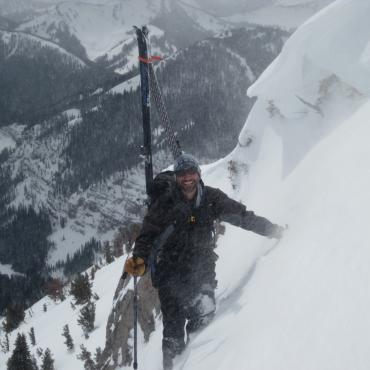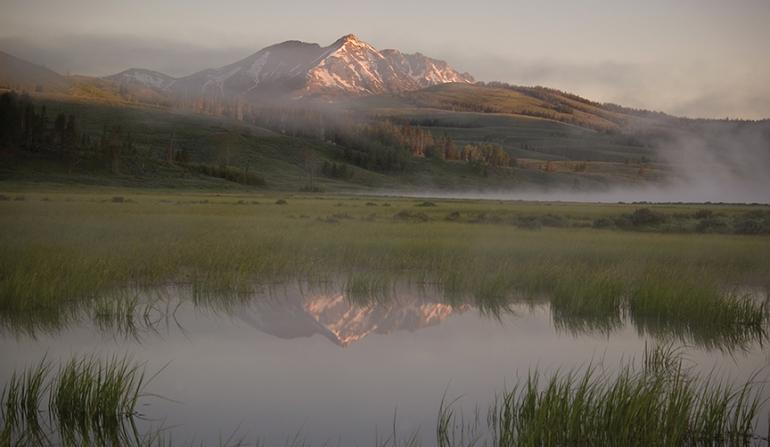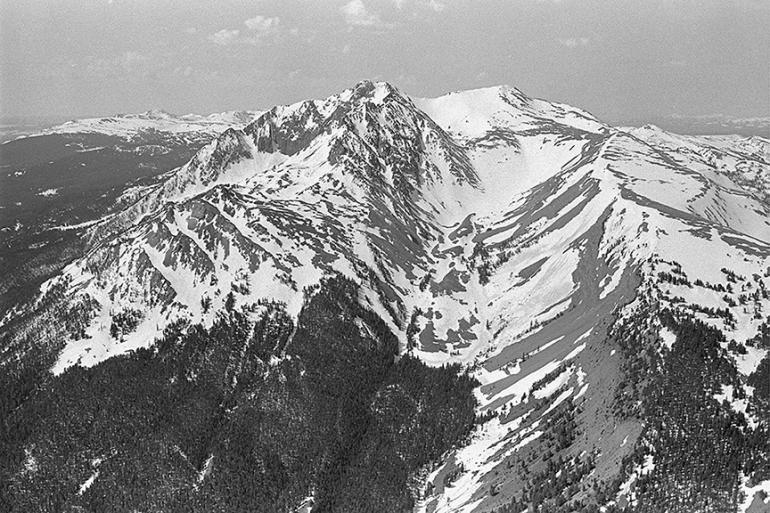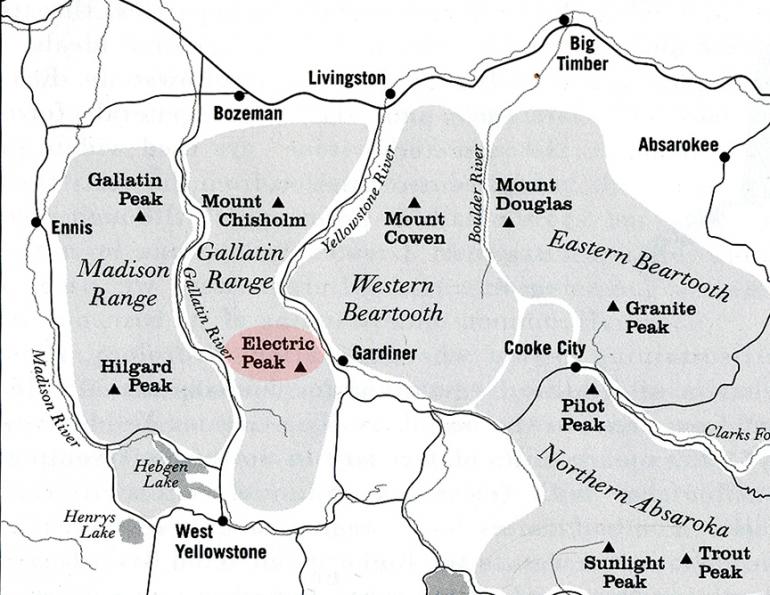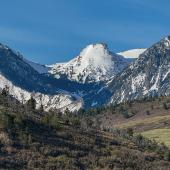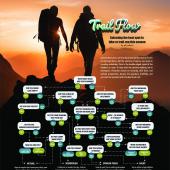The Grandest Gallatin
Climbing Electric Peak.
Electric Peak is one of Greater Yellowstone Ecosystem’s most dominant mountains, rising nearly 5,800 vertical feet above the Yellowstone River as it drains northward out of Yellowstone National Park. A climb to its summit affords a centralized view of the sea of mountains from the Madisons to the Beartooths and from the Absarokas to the Tetons. Despite its close appearance from Gardiner and the Park highway, Electric is so massive that an ascent is an all-day affair. Nonetheless, this highest point in the Gallatin Range is a prime objective and a very popular ascent.
Although Electric Peak was probably first climbed by Native American bighorn sheep hunters or early white settlers, the first known ascent was made in a wild electrical storm by Hayden surveyors Henry Gannett, Albert C. Peale, and Alexander E. Brown on July 26, 1872 from Mammoth. Peale wrote about the ascent in his 1872 report:
When we were within about 500 feet of the top a storm came up, and we were enveloped in clouds. The ascent here was very difficult, as the fragments of rock were very sharp, and most of them loose, sliding from beneath us as we climbed over them. Mr. Gannett succeeded in attaining the highest point and depositing his instruments, when he was in the midst of an electrical cloud, and his feeling not being of the most agreeable sort he retreated. As he neared us we observed that his hair was standing on end, as though he were on an electrical stool, and we could hear a series of snapping sounds, as though he were receiving the charges of a number of electrical frictional machines. Mr. A. E. Brown next tried to go up, but received a shock which deterred him. The cloud now began to settle about us, and we descended some 500 feet, and waited until the storm passed over. About 4 o’clock in the afternoon we succeeded in reaching the top, and Mr. Gannett found the altitude of the peak to be 10,992 feet above the sea. We named it Electric Peak.
Between 1878 and 1888, the peak saw a number of ascents by surveyors working to lay out the boundaries of Montana and Yellowstone, but the name “Electric Peak” first appeared on the 1893 Livingston quadrangle. In 1908, a proposal to rename it “Edison Peak” for Thomas A. Edison was rejected when Henry Gannett opposed the change. “I attached the name of ‘Electric Peak’ to the mountain referred to in 1872,” Gannett wrote, “because at that time and on this summit I first acted as a lightning rod, a rather unique experience.”
Ascent A: Beattie Gulch
From the north entrance of Yellowstone Park in Gardiner, drive 4.5 miles northwest on Old Yellowstone Trail, which follows the southwest side of the Yellowstone River. Just past the Park boundary, look for Beattie Gulch trailhead on your left. Walk or bike this excellent dirt road for 2,600 vertical feet to the north ridge of Electric Peak. Continue along the road as it crosses over the ridge and turns south through forest along the ridgetop. Pass a rock promontory and the Forbes Cabin to the right on a trail easement through a small section of private land. Bear left at a fork in the road and again at a national park sign marking the trail to “Mount Electric” in 4.8 miles.
The scenic trail leads gradually along the north ridge of Electric Peak through forest and meadows, then traverses on the steep east side of the ridge to avoid ups and downs. At the top of the highest meadow, a faint trail traverses left (southeast) across talus under the large west summit to a saddle between the summits. This traverse is quite narrow, steep, and exposed. From the saddle, a foot-trail leads toward the summit. At the first steep tower, the trail traverses right (southeast) along a convenient ledge and continues traversing across steep scree and rocks to bypass a false summit. Climb a final loose gully and ridge to gain the true summit.
Although the north ridge from Beattie Gulch is the quicker approach to the summit, a network of buckrail fences, trails, and roads score the mountainside and obnoxious fence posts mark the Park boundary every few hundred feet. The climb from Glen Creek through wild meadows and valleys to the rugged southeast ridge is much more aesthetically pleasing.
Ascent B: Glen Creek
Park at Glen Creek trailhead five miles south of Mammoth and hike the Sportsman Lake trail for 1.5 miles. Pass the Fawn Pass trail junction and continue toward Electric Peak along the south-facing bank of Glen Creek. Pass the trail junctions to Sepulcher Mountain and Cache Lake and continue toward the Gardner River. One mile past the Cache Lake trail junction, watch for the Electric Peak Spur Trail on a broad forested ridge north of the Gardner River. Follow this trail through gradual forest and meadows to the base of the southeast ridge of Electric Peak and then along the ridge until reaching rock bands near the summit. If exposure on the rocky ridgetop is too much, continue on loose talus and scree to the left (south) of the ridge. Regain the ridge and follow it to the summit by scrambling on steep, loose rock.
Vitals
Ascent A
Beattie Gulch parking elevation: 5,202 feet
Elevation gain: 5,767 feet
Distance: 10 miles
Overall grade by north ridge: II Class 2
Estimated ascent time: 4-8 hours
Maps: Mammoth, Quadrant Mountain, Electric Peak
Ascent B
Glen Creek parking elevation: 7,280 feet
Elevation gain: 3,689 feet
Distance: 10 miles
Overall grade by southeast ridge: II Class 3
Estimated ascent time: 4-8 hours
Maps: Mammoth, Quadrant Mountain, Electric Peak
Thomas Turiano is the author of Select Peaks of Greater Yellowstone: A Mountaineering History and Guide, from which this story was adapted. The book is out of print but can be purchased in CD format at selectpeaks.com. He lives, guides, and writes in Wilson, Wyoming.

